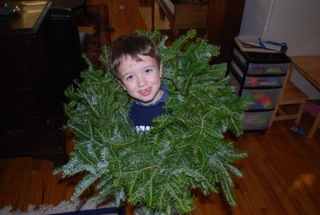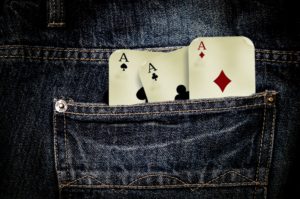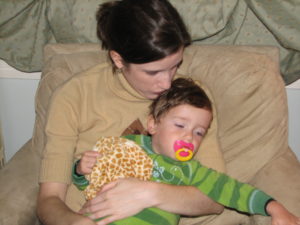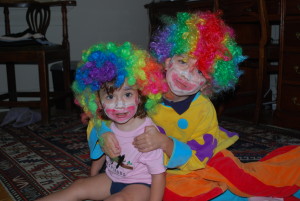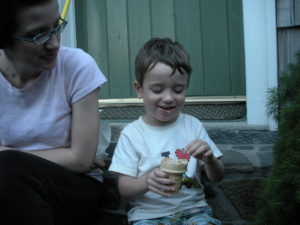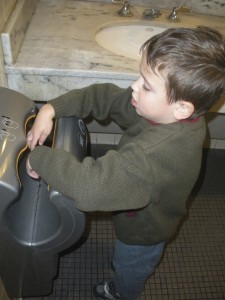
Before I had children, Autism Spectrum Disorders were my specialty. I reduced my child psychology practice to half time after James came along, and soon realized I couldn’t close the door on autism at the end of the workday, because it was in my house.
I first heard about autism in high school, at a children’s residential facility where I volunteered. Sam was lying on his back and spinning around in circles by kicking his feet, as if on an invisible merry-go-round. He wasn’t brushing his teeth alongside the other children, because he was having too much fun at his own carnival.
I determined to become part of Sam’s carnival, and eventually learned to play with kids whose parents thought they couldn’t play. So 20 years later, why did I find myself on our playroom floor, my back against the sofa, writing down everything James said, while he did his own thing? “You sit on that. You like that. You put it down there,” I transcribed, noting he had his pronouns reversed. I hope I took the time to talk to James as I wrote, but I don’t remember.
My son was a loner. It didn’t come naturally to him to connect with anyone, including – and maybe especially – me. Instead of crying or looking for help in a tough situation, James mounted a noisy protest. Every tantrum was a puzzle. When he started talking, my first sign that he’d hurt himself was hearing him screech, “No ice!” as he ran away from me. If I figured out he had a pebble in his shoe, captured him, and removed it, he calmed down immediately.
By contrast, every time I kissed James’ cheek, he would rub the spot with his hand, looking away, like a teenager. He was unaffectionate. He had sensory issues. Of course. He had autism.
I knew that underlying health issues could be a source of toddlers’ developmental and behavioral problems. So, I arranged a medical evaluation for various thyroid, allergy, immune, and metabolic problems that might have been an easy fix. And the doctor found something. We discovered that one of James’ vaccines hadn’t been effective, exposing him to frequent upper respiratory infections. And all that time I thought he had allergies. He got a booster shot and the colds went away, but the autism didn’t.
That’s right, I’m the mom who thought that a vaccine might cure her child’s autism.
Practically speaking, as part of these work-ups three-year-old James had to have his blood drawn three times in three weeks. Although James freaked out the first time, the second and third times he patiently held out his little arm as the nurse poked around for his tiny veins. She kept looking up at his face, waiting for him to blow his stack. He never did.
The nurse remarked, “This is the best-behaved child I’ve ever seen!” Then she gave him a jumbo pack of Starburst and a full roll of stickers.
Her compliment felt like an accusation. I was still out of breath from forcefully extracting James from under the Lego table in the waiting room, where he’d been holed up catlike for a half hour. Before that, I’d pried him out from under the car seat, and then carried his noodle-like body through the parking lot. Back at home, he’d resisted brushing his teeth, getting into his clothes, leaving the house, and getting into the car. The whole way out to the suburban office he’d looked out the window, exclaiming with joy anytime he saw a construction truck. But each time a truck disappeared from his view, he’d kick the back of my seat.
James was a good boy, just not for me.
As my office became a refuge and I accepted a patient who would eventually become James’ first friend, I began to wonder whether I was ever meant to be a mother. One evening, my infant daughter asleep on my shoulder and a glass of gin in my hand, I made a suggestion to my husband Bruce. Maybe I was better off, and James was better off, and the community would be better off, with me as a psychologist rather than as a mother.
A parent-ectomy. That’s what Bruno Bettelheim proposed in his 1967 book, The Empty Fortress, a book my parents might have read if I’d had autism. Early professionals observed that mothers whose children had autism were cold and distant: Refrigerator Mothers. But sometimes it feels better to focus on doing right by your child, than to interact with him. Contemporary studies refer to “parental stress” and investigate the effects of having a child with autism on the parents.
Instead of condemning me for my cold-hearted suggestion, Bruce appealed to my sense of reason. “Think of your favorite families you’ve worked with, your favorite adults with autism,” he suggested. “What did they all have in common? Good psychologists, or good parents?”
Kids in our town had some choices when it came to psychologists. But James had only one mother.
Around this time, I came across a newspaper article. Researchers at the Yale Child Study Center, my old stomping ground, found that administering oxytocin, “the love hormone,” led to activation in the brain’s social regions in a small sample with mild autism. I wondered where I could get some oxytocin for James, and then flagellated myself for wondering.
James needed a mother’s love, and I was giving him everything but that.
I stopped reading about autism, and started reading about motherhood. I especially liked Erma Bombeck, who wrote, “A child needs your love most when he deserves it least.” At first I took my fondness for this quote as further evidence that I’d become a refrigerator mother, but later I realized how many kids it’s kept alive.
So James didn’t know how to connect with people. I did. It was time to show him how.
Neglecting to tell Bruce where I’d learned it, I pulled out the trusty “basket hold,” a form of restraint I’d used during my internship in a children’s psychiatric hospital. It was the only way to get ahold of James. You grab the child’s wrists, cross them in front of him, and pin his body in your lap with your legs crossed over his legs and his head under your chin. It’s a hug you can’t refuse.
As I held James I would say things like, “I know you’re mad because your toy broke. No biting, though. That hurts me. You’re my boy. Mommy loves you no matter what.”
I was talking to myself, more than James.
Over time, I didn’t have to hold James so tight to keep him near me. When he was really upset, he’d often give up his struggles and sob on my shoulder. Then I really felt like his mother.
One day after a basket hold I kissed James wetly on the cheek, and he immediately wiped it off. I decided to ask him about it. How did I know why he did it?
“Did you wipe that kiss off?”
“No,” James said, still rubbing.
“Well, what are you doing?” I asked.
“Rubbing it in. That way it makes you love me more.”
Now at this point, James had his pronouns reversed. So, he probably meant, “It makes me love youmore.” But who cares what direction he was heading? The fact that the word “love” was in his vocabulary suggested I was on the right track.
Author’s Note: James still struggles with the stresses of everyday life, and our family struggles along with him. But I don’t dwell on the word “autism” as much as I did when I started writing this piece. Instead, I focus on James’ love of guitar and flag football, and on his strong relationships with his family, neighbors, teachers, and friends. I’m proud to say he’s the only member of our family who’s consistently described as “sweet.”
Bio: Lynn Adams is now a full-time wife and mother in New Orleans. Her work has appeared on Salon, Brain, Child, and The Mid, as well as in the anthology, It’s Really 10 Months: Special Delivery. Find more at www.lynnadamsphd.com.

